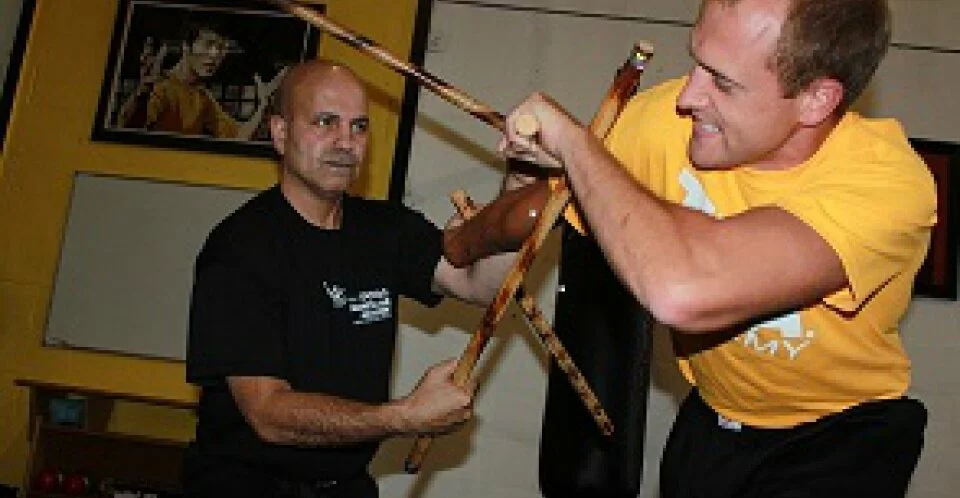
Understanding Kali - 3
Kali - Ultimately an Empty Hand Art
By Lakhvinder S. Madahar
Introduction
Over two and a half decades ago I remember reading a small essay on a criminal law case with great interest. Not something I would normally pay attention to, however the difference here was it appeared in a martial arts magazine (Karate and Oriental martial arts). Actually looking back on it, hardly any thing was said about either the attacker or the victim, except for one memorable quote from the judge; “I can not comprehend, how anyone can strike twenty-nine times in a single attack”. He was referring to a Filipino martial artist involved in the case. To this day I am not aware if the wounds were caused with a stick, knife or empty hands, all equally possible for a Kali fighter.
Humble Beginnings in Kali
At the time, knowledge on the Filipino martial arts was limited and I had not seen as much of the Filipino martial arts as I would liked; but the judges quote above captured my imagination and inspired me to continue researching and training in these elusive arts. Despite having a limited amount of material to work from, no instructor to receive instruction from or ask questions, and obviously no club to belong too, as for training partners, let’s just say they were less then enthusiastic; they didn’t have the same enthusiasm and trained only once in a while.
As for myself, I like to believe I had a healthy interest in the martial arts since I’ve been aware of them, at times however, in certain arts my interest got a little obsessive. Kali has always been my firm favourite, almost right from the beginning, followed by (in no specific order) Muay Thai, Jeet Kune Do, Wing Chun, Silat, Yoga, Gatka, and now the grappling arts.
Purely out of interest, I’ve always had a keen eye for the latest books, DVD’s/Videos and seminars. Even now I quite often take a leisurely trip to the local library and book stores, to update myself. Over the years I’ve come across some really excellent books and magazines on the Filipino martial arts, but on the rare occasion some fairly poor ones. For example a couple of the (so called) Martial Arts Encyclopaedias do spring to mind. Once I was surprised to see Kali being described as; Filipino Karate, similar to Kendo, and even Aikido!
Shadow
Kali is not necessarily a weapons only martial art as commonly believed, but is a weapons based martial art, just like most other ancient martial arts; as Karate, Kung Fu, Klaripayate, Muay Thai, Jeet Kune Do and so forth. As the title of this article states, Ultimately Kali is an empty – hands art originally from the Filipino islands, now also popular in America and across the globe, but in most cases the empty hands are either practiced under the shadow of the weapons sub – systems of Kali or not at all.
Observations
As an instructor, I’ve become aware that most people that take up Kali come from other styles/systems. In search of some stick work and knife techniques, either to learn it for personal growth, to add it to there own syllabus or both. In a lot of cases they have already reached a high level of expertise and are Black Belts in their system/systems. They are usually looking for either a change and/or are trying to fill in the gaps found in their original art. More often then not the biggest gap is the lack of functional weaponry skill and knowledge, this is not to say other martial arts don’t have adequate knowledge and skill in weaponry. It’s just that if they do have it, then it is usually passed on to a selected few, only after the student has reached a Black Belt grade or its equivalent. As they consider the weapons portion of the art to be the advance skill level, more deadlier portion of the art and moral value. It also gives the instructor/master a chance to check out the student’s character as it is extremely important to for the student to posses the correct moral attributes.
Head Heat
This brings me to a Filipino master Regino Ellustrisimo who is mentioned in Guro Dan Inosanto’s book. He could measure the heat from the top of a persons head and claimed by doing so he could tell if the person is of the correct temperament and he simply would not teach Escrima to a hot tempered person. Guro Dan mentioned this on one of his seminars and said that he asked him what if he had fever on the day would this mean that he would not be taught the art, to which he replied no it’s a different kind of heat his feeling.
Now days many of the Kali instructors themselves are verse in more than one discipline, some of them chose to start a new student in some form of kick boxing programme before being introduced to kali. They feel the need to monitor the student, just as the guys from other martial arts mentioned above.
Cross Over Point
Since nearly all Filipino martial artists, begin to teach their art with a stick or a knife as it was done traditionally, the sub – systems of sticks and knives are flourishing over the empty hands of Kali within the martial arts community. One of the many reasons for this is because Kali is such a vast art, lot of the students studying it don’t stay in it long enough to cross over to the many fascinating sub – systems of empty hands.
Occasionally I’ve come across, numerous groups who were really heavily into their weapons training and have allowed the empty hands of Kali to be completely over shadowed by the weapons into complete darkness. What ever the reason, they seemed pretty content with just the stick fighting portion of Kali and had chosen not to be immersed by the light of Panantukan. There isn’t any thing really wrong with this, provided they are aware that there is this fantastic empty hand art within the subsystems of Kali and then choose not to invest any training time and money into it. But if they think that stick fighting or just weapons is all Kali has to offer is a bit like practicing in the dark and perhaps best left to the Ninja’s. These days, luckily, there are fewer barriers to learning the Filipino arts. Information is widely available through, DVDs’, magazines, books and several high class instructors. If then they still feel the unarmed skills they had developed from the previous styles are adequate, then they’ve made a valid choice.
As mentioned earlier, there isn’t any thing wrong with this, just as not every Muay Thai fighter is also versed in the art of Krabi Kraboong or you don’t get every black belt Dan grade training in the art of Bo, Katana, Tonfa, Sai, Nunahaku, and the Jo.
Same View at the Top
In Kali the training usually begins with the single rattans stick and progresses to the double rattan sticks and the long and short rattan sticks. But not always, if the instructor chooses to begin the students training with the double sticks, the empty hands or the knife, it’s just a different path, leading to the same peak; the view at the top is the same. If the journey is completed!
In the Filipino martial arts almost, always the beginner student will receive their introduction to Kali with the single stick and on the odd occasion with the knife and on other occasions the empty hands, but the rattan stick is the most common.
There’s no escaping the fact, Kali is better known for its sticks and knives skill and most people come in to Kali, because of it. This is quit understandable as the swords, sticks, knives, whips, Tabak Toyoks and the Staffs do out shine the Filipino boxing (Panantukan), Filipino grappling (Dumong/Buno), Filipino trapping (Tapi – Tapi) and even Filipino kicking (Panantukan). Now there are some excellent Kali schools, which practice the empty hands portions along side by side the weapons portions, whilst keeping a good balance between the two.
The Same, But Different
Generally in the martial arts world when someone witness Kali students practicing with rattan sticks and/or knives it is immediately recognised as the Filipino martial arts in action.
However, this wouldn’t be the case for many of the other sub systems of Kali, for example; if an onlooker with little or no martial arts understanding was to witness a Panantukan display, chances are it would be dismissed as western boxing, if it was Pananjakman again the chances are it could be dismissed as a kicking art from another country, specially Muay Thai as the round kick in Kali is also delivered with the shin in most cases. This actually happen to me when a friend and a fellow (Phraya Pichai Muay Thai) instructor come over for his private lesson from Solihull, as I was watching Guro Dan’s Panantukan video. We watched it without saying too much before he suddenly burst out with that’s ‘Thai Boxing’, to which I just replied ‘keep watching a little longer’ knowing that Guro Dan could explain it far better then I ever could. Then a few more minutes later he obviously knew better. But to be fair to my colleague, I have to agree with the bit he was referring to, did strongly resemble Muay Thai.
So it is with Filipino Dumong/Buno (Filipino grappling) I can see just how easily it could be mistaken for one of the grappling arts from Japan or Brazil, the Filipino Tapi Tapi (trapping) could easily be mistaken for Wing Chun trapping. Some aspects of the Hubad drills can look identical to the lop sau cycle from the Wing Chun system and even the push hands drill from Tai Chi. I think by now everyone must be getting the idea.
The Whole Rainbow
Hopefully this article has made a few people aware that, it’s not a bit of light that’s failing to shine through the dark shadows, but a whole rainbow. As a closing note for this month, give the rest of Kali a chance, it’s just as good as the stick portion of the art. Let’s get colourful!
Conclusion
Thank you for reading this article, hope you enjoyed it. Each month I will be covering a topic, on various weapons, empty hands, concepts and principals that govern the Filipino martial arts and some actual techniques will also be discussed. If you have any comments or questions, feel free to drop us a line.
www.thaiboxing-coventry.co.uk
For more information on;
Personal one on one session, group sessions or training
Total Martial Arts Academy - Coventry.
Call Lucky Madahar mobile: 078 34 767 487
Email: [email protected]







